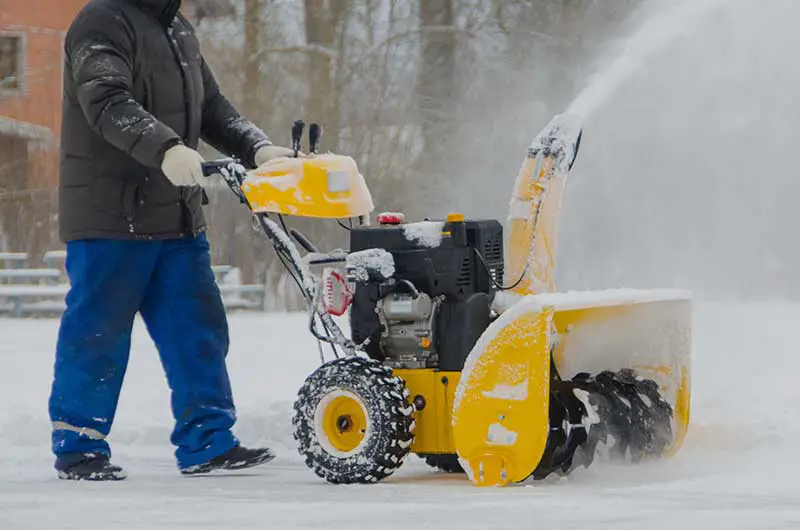To use a snowblower, prepare your snowblower by checking fuel, oil, spark plug, and belts. Start the snowblower, choose the right speed, engage the auger, guide the snowblower, and direct the snow discharge. Follow safety tips and store your snowblower properly after use for optimal performance.

Using a snowblower can make the task of clearing snow from your driveway or walkway much more manageable during the winter months. This guide will help you learn how to safely and effectively operate a snowblower.
Preparing Your Snowblower
Before starting your snowblower, ensure that it is in good working order:
- Check the fuel: Make sure the fuel tank is filled with fresh gasoline. Consider adding a fuel stabilizer if the snowblower has been sitting idle for a while.
- Inspect the oil level: Check and top off the oil level as needed. Refer to the owner’s manual for the recommended oil type and quantity.
- Inspect the spark plug: Check the spark plug for wear or damage and replace if necessary.
- Check belts and cables: Inspect belts and cables for wear or damage, and replace them as needed.
Starting Your Snowblower
Refer to your snowblower’s owner’s manual for specific starting instructions. Typically, starting a snowblower involves setting the choke, engaging the safety key, priming the engine, and either using an electric starter or pulling a starter handle.
Operating Your Snowblower
Follow these steps to effectively operate your snowblower:
- Choose the right speed: Select an appropriate speed for the snow conditions and your comfort level. Start at a slower speed and gradually increase as you become more familiar with the snowblower’s operation.
- Engage the auger: Engage the auger control to start the snowblower’s snow-clearing mechanism. This will begin to draw snow into the machine.
- Guide the snowblower: Gently guide the snowblower forward, allowing it to do the work. Do not force the machine, as this can cause strain on the engine and potentially damage the snowblower.
- Direct the snow discharge: Adjust the chute direction and angle to direct the snow away from areas you have already cleared or don’t want to cover. Keep in mind the wind direction to avoid blowing snow back onto yourself or cleared areas.
- Clear in a pattern: Clear your driveway or walkway in a systematic pattern to minimize the amount of snow you need to move. For example, start in the middle and work your way outward or make successive passes, moving from one side to the other.
Safety Tips
- Read the owner’s manual: Familiarize yourself with your snowblower’s specific safety features and operating instructions.
- Wear appropriate clothing: Wear warm, weatherproof clothing, and non-slip footwear when operating a snowblower.
- Avoid loose clothing and accessories: Loose clothing, scarves, or jewelry can get caught in the snowblower’s moving parts, leading to injury.
- Use caution on slopes: When clearing snow on a slope, operate the snowblower across the incline, rather than up and down, to minimize the risk of tipping.
- Never clear the chute with your hands: If the chute becomes clogged, turn off the engine and use a snowblower clearing tool or a broom handle to remove the obstruction. Never use your hands to clear the chute.
Storing Your Snowblower
When you’re finished using your snowblower, follow these steps for proper storage:
- Turn off the engine: Turn off the engine and allow it to cool before storing the snowblower.
- Clean off snow and ice: Remove any snow and ice buildup from the auger, chute, and other parts of the snowblower.
- Check for damage: Inspect your snowblower for any damage, wear, or loose parts, and address any issues before storing it.
- Drain fuel or add stabilizer: If you don’t plan to use the snowblower for an extended period, drain the fuel or add a fuel stabilizer to prevent fuel degradation.
- Lubricate moving parts: Lubricate the snowblower’s moving parts as recommended by the manufacturer to ensure smooth operation next time you use it.
- Check and tighten fasteners: Inspect and tighten any loose bolts, nuts, or screws to ensure the snowblower’s structural integrity.
- Store in a dry, cool place: Keep your snowblower in a dry, cool, and well-ventilated area, away from open flames or sparks.
By following these steps and practicing proper snowblower use and maintenance, you can keep your snowblower running efficiently and safely throughout the winter season.
